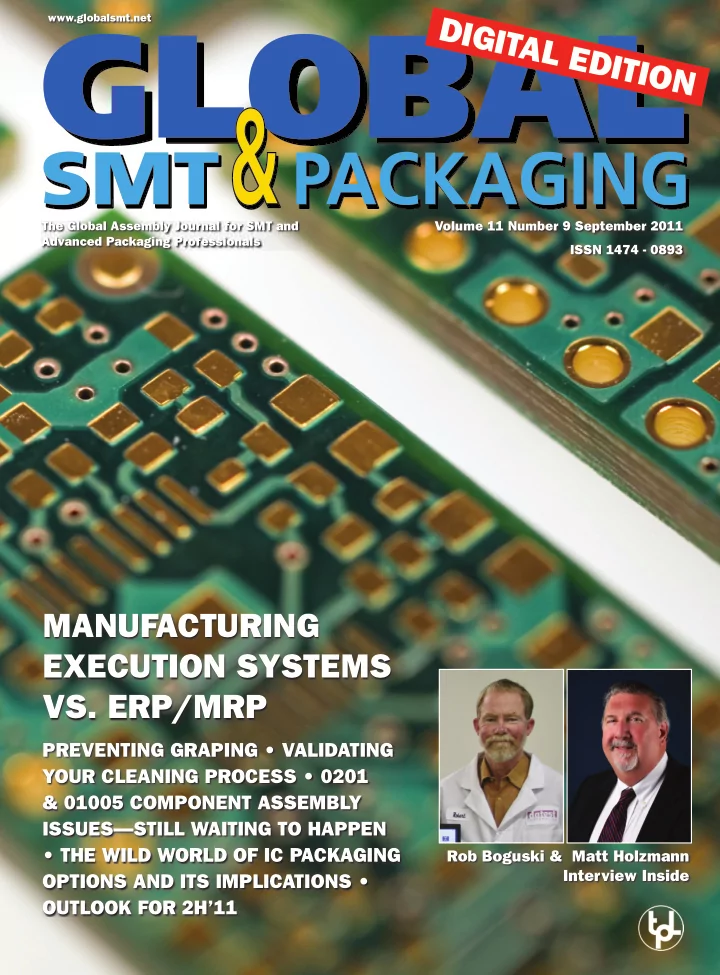

�������������������������������� ����������������� ������������������������������� ��������������������������������� ������������������������������� ��������������������������� ����������������������������� www.globalsmt.net ��������������� The Global Assembly Journal for SMT and Volume 11 Number 9 September 2011 Advanced Packaging Professionals ISSN 1474 - 0893 MANUFACTURING EXECUTION SYSTEMS VS. ERP/MRP Rob Boguski & Matt Holzmann Interview Inside
Manufacturing execution systems vs. ERP/MRP Manufacturing execution systems vs. ERP/MRP T e myths and realities of coexistence in today’s electronics manufacturing environment Bill Crowley, Optimal Electronics, Austin, Texas, USA Can manufacturers achieve Introduction manage manufacturing-specific resources. T ese systems o ff er an array of capa- In today’s complex electronics assembly greater management insight bilities for enabling companies to e ff ec- environment, plant managers have an and control over all phases of tively and e ffi ciently control many critical ever-increasing need for greater manage- the manufacturing production aspects of their operations, with signifi- ment insight and control over all phases cant inherent value for finance and supply of the manufacturing production process. process through their enterprise chain departments. More specifically, ERP/ Manufacturers are constantly being chal- resource planning (ERP) and MRP systems typically help companies lenged to find new and better ways to meet manufacturing resource planning standardize and automate key business changing production demands and sched- practices, gain visibility into mission-crit- ules, automate manual processes, reduce (MRP) systems alone—or ical data, manage customer relationships, overhead costs, optimize production does it require the specialized achieve compliance with financial report- throughput and achieve new e ffi ciencies functionality that only a ing requirements, maintain better inven- that ultimately lead to greater profitability. tory control and more e ffi ciently manage manufacturing execution system Realizing these outcomes requires company resources. new technologies, tools and processes that (MES) can provide? This paper Companies typically implement ERP/ can deliver significant new capabilities for explores the key considerations MRP systems to alleviate major business production improvement, materials man- and issues that surround this pressures, such as lowering operational agement, traceability, process enforcement costs, increasing scalability for accommo- and quality management. A comprehensive, often-debated topic, in an attempt dating growth, and improving customer integrated approach is crucial for provid- to dispel the myths, realities and service and satisfaction. More specifically, ing real-time visibility and e ff ective utiliza- misunderstandings regarding the an ERP system e ff ectively translates a cus- tion of shop floor data for better planning, tomer order into a “so f ware roadmap” for decision-making and execution across roles each of these systems play in monitoring the various steps along the every aspect of the production process. today’s electronics manufacturing path to fulfilling that order—while the T e question is…can manufactur- environment. MRP system helps the company plan and ers achieve these outcomes through their manage the manufacturing resources asso- enterprise resource planning (ERP) and ciated with that order, such as materials manufacturing resource planning (MRP) purchasing, bill of materials processing, systems alone—or does it require the spe- and overall inventory control. cialized functionality that only a manu- By establishing standardized opera- facturing execution system (MES) can tional procedures and automated processes, provide? manufacturing can be better integrated with logistics and delivery, and real-time ERP and MRP: The visibility can be gained into the status of operational backbone processes from “quote to cash”—which in ERP and MRP systems have traditionally turn enables better management insight provided the essential operational back- and decision-making. T e following sum- bone for manufacturing companies. While mary provides a high level snapshot of ERP systems are key for facilitating the flow some of the main motivating factors that of information between business functions drive companies to implement ERP/MRP inside the boundaries of the organization, systems into their core operations: as well as the company’s connections to outside stakeholders, MRP systems provide Integration of financial information : By the production planning and inventory providing a consolidated repository for control capabilities needed to e ff ectively all financial information, to be used by all 10 – Global SMT & Packaging – September 2011 www.globalsmt.net
Recommend
More recommend